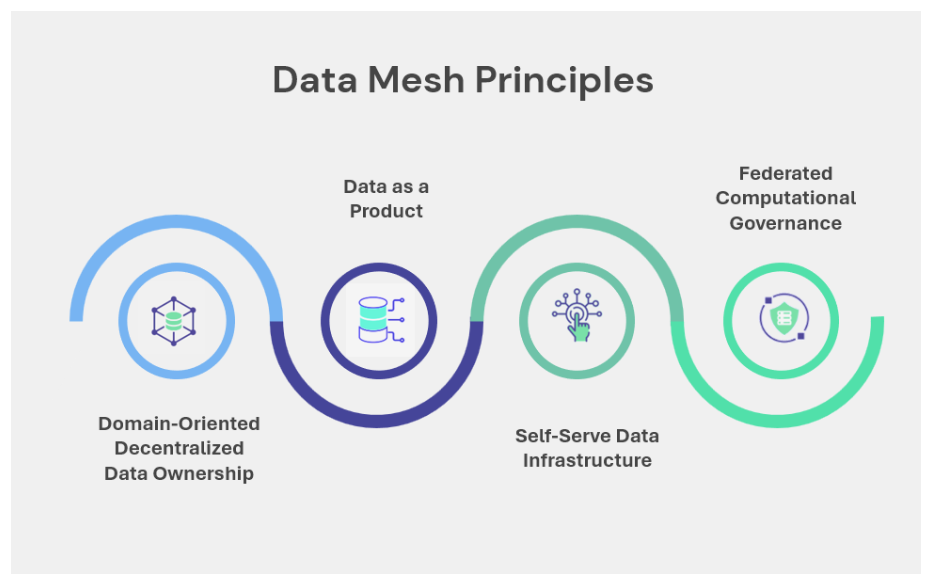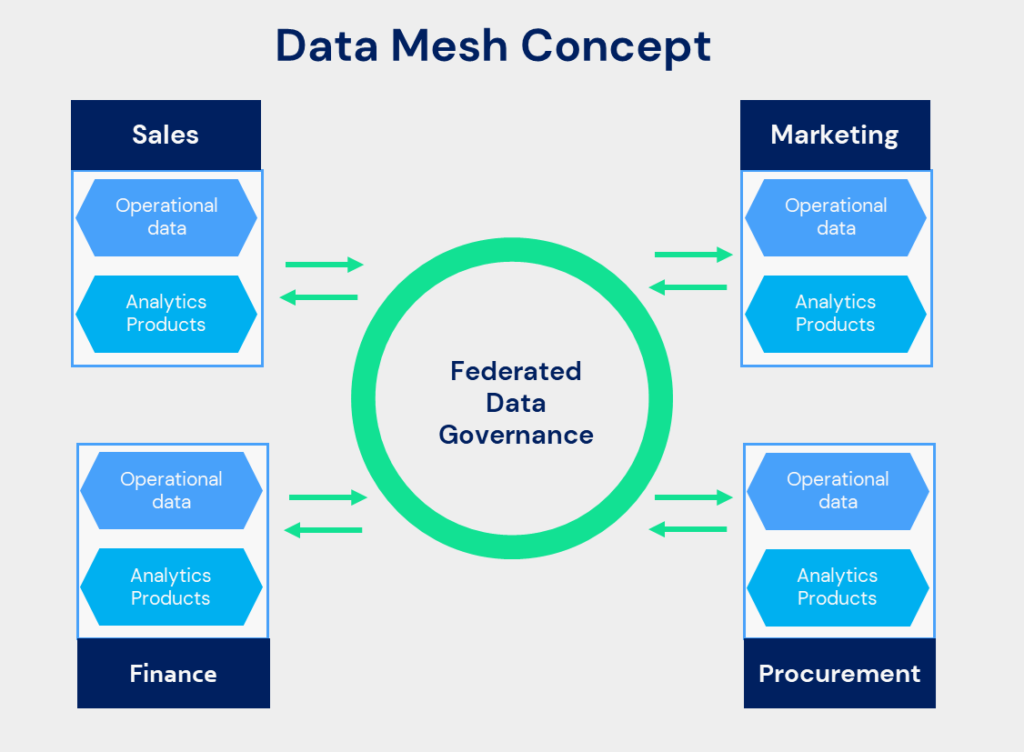In the rapidly evolving landscape of Retail and Consumer Packaged Goods (CPG),
organizations are constantly seeking innovative ways to harness the power of data.
One emerging approach that promises to revolutionize data management and
analytics is the Data Mesh architecture. This blog explores how Data Mesh can drive
innovation and efficiency for Retail and CPG organizations, providing an in-depth
look at its principles, benefits, and a case example of how we worked with a CPG
company to leverage this architecture for various analytics product development.
Understanding Data Mesh Architecture
Data Mesh is a decentralized data management paradigm that treats data as a
product and aligns data ownership with domain teams. Unlike traditional centralized
data architectures, Data Mesh decentralizes data ownership and responsibilities to
domain-specific teams, fostering a culture of collaboration and accountability. Here
are the key principles of Data Mesh:
1. Domain-Oriented Decentralized Data Ownership
- Data is treated as a product with its own lifecycle, prioritizing user experience and value creation.
- Teams are accountable for delivering high-quality, reliable data products.
2. Data as a Product
- Data ownership is distributed to domain-specific teams who understand the data best.
- Each team is responsible for the data quality, governance, and availability.
3. Self-Serve Data Infrastructure
- Empower domain teams with the tools and infrastructure they need to build, deploy, and maintain data products.
- This includes data pipelines, storage solutions, and analytics platforms.
4. Federated Computational Governance
- Establish governance policies that are enforced automatically across all domains.
- Ensure compliance, security, and data quality through automated checks and balances.
Benefits of Data Mesh for Retail and CPG Organizations
Implementing a Data Mesh architecture offers several key advantages for Retail and
Consumer Packaged Goods (CPG) organizations. One of the primary benefits is
enhanced agility. By decentralizing data ownership, domain teams can quickly
develop and deploy data products without relying on a centralized IT team. This
decentralization reduces bottlenecks and accelerates innovation, enabling faster
responses to market changes and customer needs.
Another significant advantage is improved data quality. When domain experts are
responsible for maintaining their own data, the accuracy and relevance of data are
greatly enhanced. This domain-specific stewardship ensures that data is more
trustworthy and valuable, leading to better decision-making across the organization.
Data Mesh also supports scalability, which is crucial for growing organizations. As
Retail and CPG companies expand, a Data Mesh architecture allows for scalable
data management by enabling each domain to independently scale its data
operations. This flexibility helps organizations manage growth more effectively
without being hampered by rigid, centralized systems.
Lastly, Data Mesh fosters innovation by providing easy access to high-quality data.
Teams across the organization can focus on developing innovative analytics
products and solutions, driving a competitive edge in the market. By breaking down
data silos and democratizing access, Data Mesh architecture empowers teams to
experiment, iterate, and deliver value more efficiently.
Case Example : CPG Company Adopts Data Mesh for Analytics Product Development
We helped a leading CPG company recently to help adopt Data Mesh architecture.
Here's how we leveraged this approach to drive innovation and efficiency:
Background
The client faced challenges to streamline its analytics product development given
data silos, slow development cycles, and poor data quality which hindered their
ability to innovate.
Approach & Implementation
We worked with various stakeholders within the client organization to understand
their challenges and were able to align them to follow a centralized data governance
framework by implementing data mesh architecture. The solution implemented had
following key tenets:
1. Domain-Oriented Teams : We helped client reorganize its data management structure, assigning data ownership to domain-specific teams such as Marketing, Sales, and Supply Chain.
2. Self-Serve Infrastructure : We helped deploy a self-serve data platform, providing teams with the tools to build and maintain their data products. This included data lakes, ETL pipelines, and analytics tools.
3. Data as a Product : Data products for each domain team was developed with clear documentation, APIs, and user interfaces, ensuring other teams could easily consume and use the data.
4. Federated Governance : Automated governance policies were established, ensuring data quality, security, and compliance across all domains.
Analytics Product Development
Leveraging Data Mesh architecture, the client was able to develop innovative
analytics products like Promotions ROI and Demand Forecasting, with several others
in the pipeline. This approach significantly reduced the time-to-market for these
products by 50%, enabling faster responses to market needs.
The Data Mesh implementation also led to improved data quality by empowering
domain teams to manage their data, resulting in more accurate and relevant insights
for decision-making. This structure fostered collaboration, promoted rapid
experimentation and drive innovation. Additionally, streamlined data management
processes enhanced operational efficiency, leading to cost savings and optimized
workflows. Overall, the Data Mesh approach provided the company with a more
agile, innovative, and efficient data strategy.
Conclusion
Data Mesh architecture offers a transformative approach to data management for
retail and CPG organizations. By decentralizing data ownership, treating data as a
product, and providing self-serve infrastructure, companies can enhance agility,
improve data quality, and drive innovation. The case study of the CPG company
demonstrates the tangible benefits of adopting this architecture, showcasing how it
can lead to successful analytics product development and operational efficiency.
Embracing Data Mesh can position retail and CPG organizations for future success,
enabling them to stay competitive in an increasingly data-driven world.
Is your organization ready to transform its data management strategy?
Explore the possibilities of Data Mesh architecture and unlock the potential of
your data to drive innovation and efficiency.


